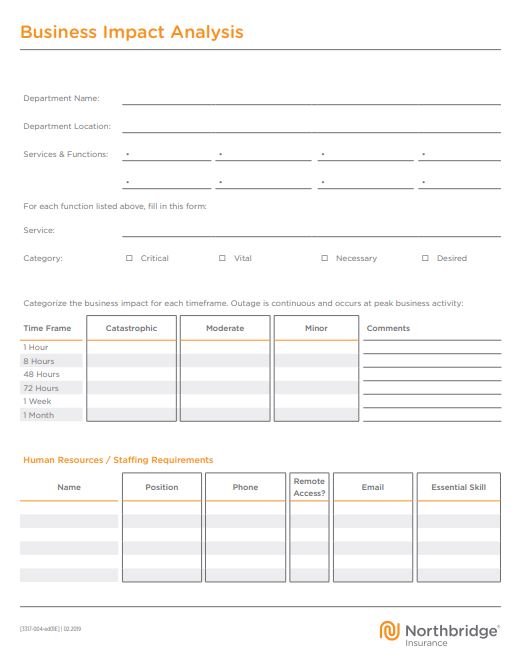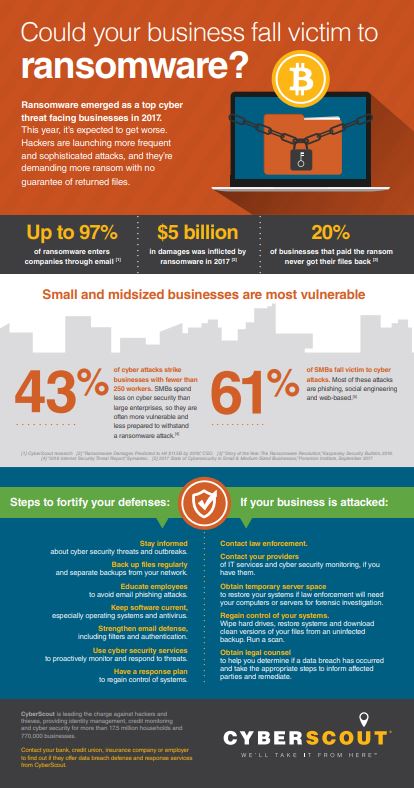Risk has surged across all industries in recent years. From changing weather patterns to advances in technology, problems can come at you from all angles – is your business continuity strategy robust enough to carry you through a sudden interruption?
Business continuity for 2019: four areas to watch
As digital, social, and geographical relationships become more complex, it’s more important than ever to stay on top of the risks your business faces, and build (or adjust) your business continuity plan to suit your needs. As you put that plan together, keep in mind these four types of business risk in the year ahead.
 A business impact analysis form is an important element in a business continuity plan. Download our template to get started on yours!
A business impact analysis form is an important element in a business continuity plan. Download our template to get started on yours!
1. Wildfires, wind storms, and floods (oh my)
Calgary dealt with severe flooding in 2013, and 2016 was the year of the devastating Alberta wildfires. Ice storms took out the power of many Quebec residents in 2018, and Eastern Canada has dealt with major flooding. In fact, severe weather alone caused nearly 2 billion in insurable damage in Canada last year.
Weather-related destruction, loss, and interruption was all over Canada in 2018, but who was hit hardest? The Insurance Bureau of Canada (IBC) points to a single windstorm that swept through Ontario and Quebec in May, resulting in over $410 million in insured damage.
But it’s no secret that the financial consequences of weather events can be significant – for everyone. In fact, IBC points out that, for every dollar paid in insurance claims to homes and businesses, Canadian governments pay out an estimated 3 dollars to recover public infrastructure damaged by severe weather.
So, what does this mean for your business? That depends on everything from where you’re located to the nature of your assets. Seed and produce farmers could be at risk of tremendous loss if severe hailstorms, tornadoes, or drought sweeps over their region, while any business near a major waterway should be prepared for flooding.
IBC points out that, for every dollar paid in insurance claims to homes and businesses, Canadian governments pay out an estimated 3 dollars to recover public infrastructure damaged by severe weather.
Climate change continues to take centre stage as the world warms, and next year will likely bring some more extreme weather events. You should consider preparing for those that are most likely to affect your region as part of your business continuity strategy.
2. Cybercrime is heating up, too
Cyber breaches are commonplace, and cyber criminals are ramping up their efforts in creative new ways. Ransomware, for instance, was once deployed randomly; now there are more targeted attacks focused on major organizations. And cryptojacking schemes – attacks that aim to infect devices and mine cryptocurrencies, effectively skipping the ransom payment stage – are streamlining the process for thieves.
Although big businesses seem to attract a lot of attention from hackers, any company that interacts online could be caught in the crosshairs. And the headache doesn’t end with the data breach recovery efforts of your IT department: growing regulation around cyber breaches could mean more effort, and more people in the organization, are required to preserve business continuity.
Some business continuity experts warn that with growing concern among regulators, businesses could soon have less time to report a breach, and face greater penalties when data is lost.
3. Your reputation rides on your response
Whether it’s a data breach, a devastating storm, or another sudden and severe threat to your business, the way you handle it is more important than ever.
The prevalence of social media and digital communication means word spreads fast – your business has precious little time to respond before your reputation could take a big hit. Some experts predict that 2019 will bring even greater scrutiny: communities are more likely to judge organizations based on their responses to emergency situations. In the wake of a disaster, your public relations will need to take centre stage.
Keep in mind that purchasing decisions can rest heavily on perception. If your audience sees your business as careless, not in tune with public opinion, or more concerned with profit over ethics, their collective outcry can ring loud and clear. It’s more difficult to recover from a poor reaction than you might imagine; be sure you’re ready to take the right steps immediately after the event, and document those steps in your business continuity plan.
4. Social and political shifts can raise the stakes
The world is churning: governments are changing (sometimes violently), trade wars are ramping up, and national relationships are being tested. Global volatility will mean uncertainty for some businesses – especially when the work crosses borders.
For manufacturers and wholesalers, supply chain issues could challenge the way you do business; trucking and logistics companies might find new concerns arising as they move goods around. Whatever your industry, changing avenues and barriers to business interactions can complicate matters. When building your business continuity strategy for this year, consider what would happen if the operations of your vendors, partners, and producers were disrupted. After all, those consequences can affect your operations, too.
Take stock of your risks and resources
Predicting what pitfalls may lie ahead is difficult, but it’s a good exercise to help position your business for a strong and focused response. Of course, you’ll also need to consider the unique elements of your business: building a small business continuity plan could require a different approach than you’d take for a larger company. Think about your resources, and how best to put them into action if a sudden event threatens to sideline your business.
Not sure where to begin? Check out our business impact analysis form to help you start your plan.





